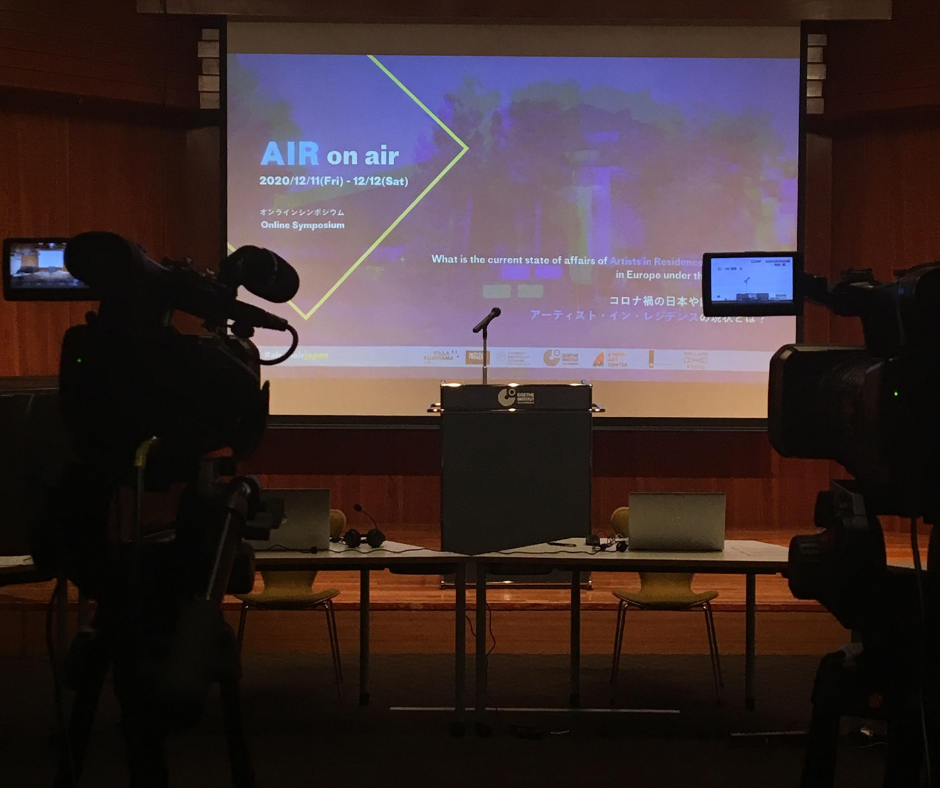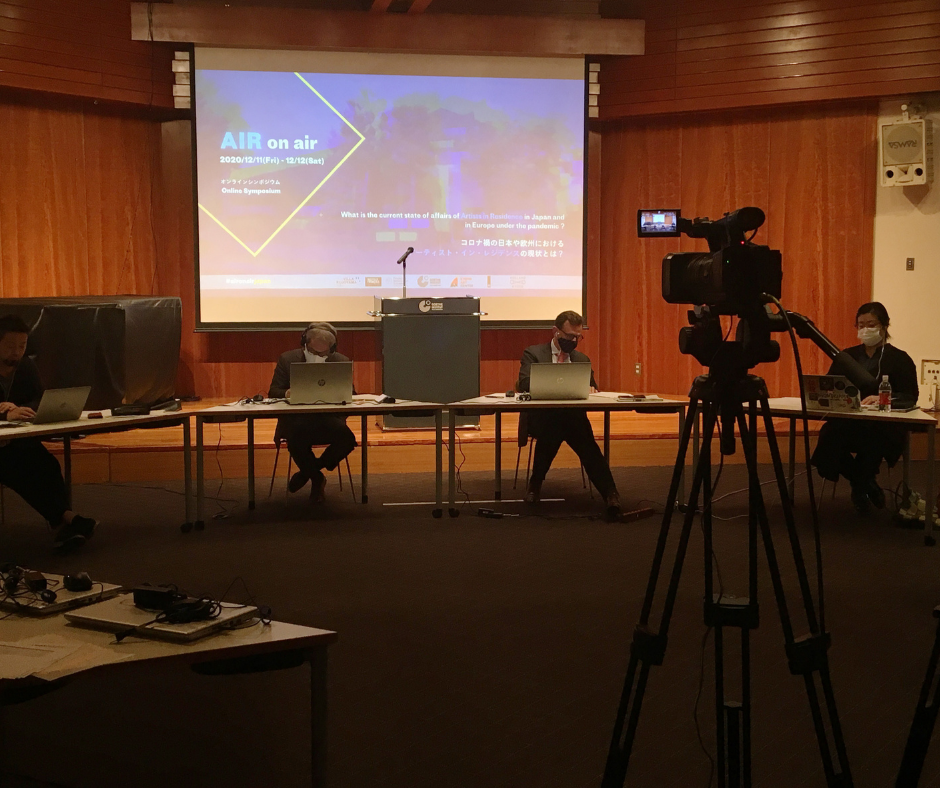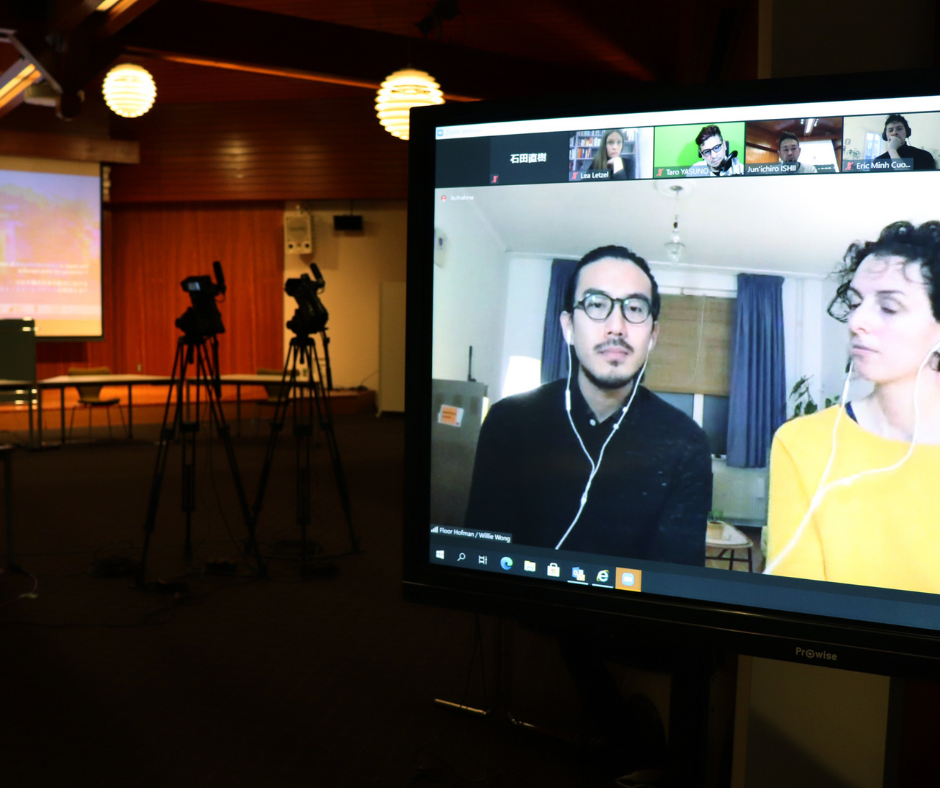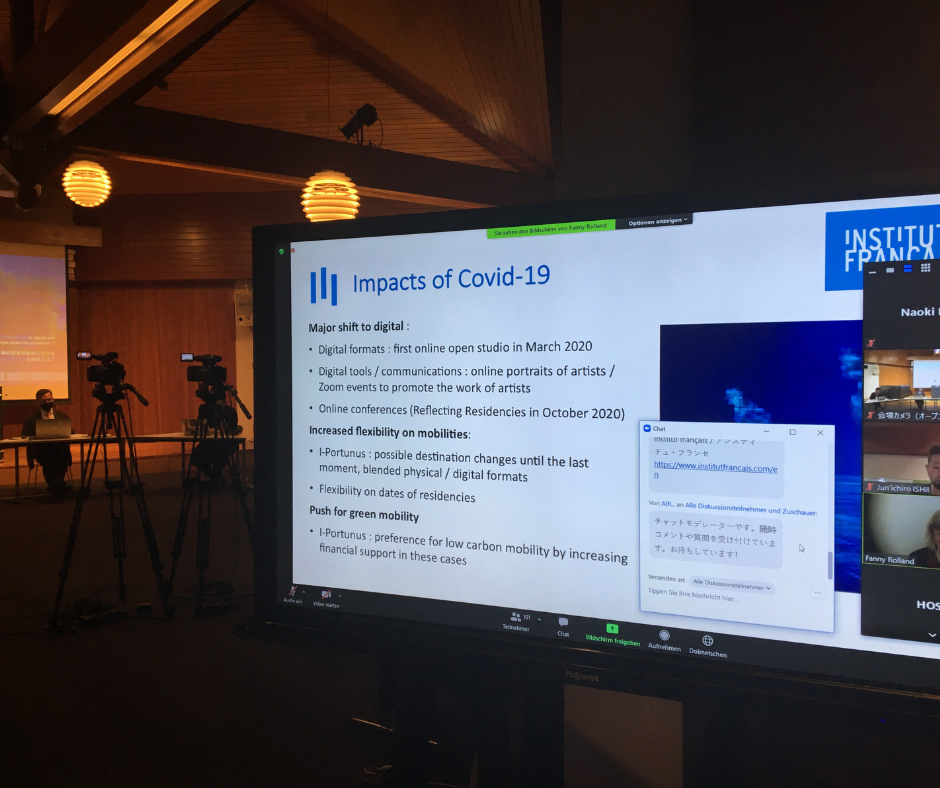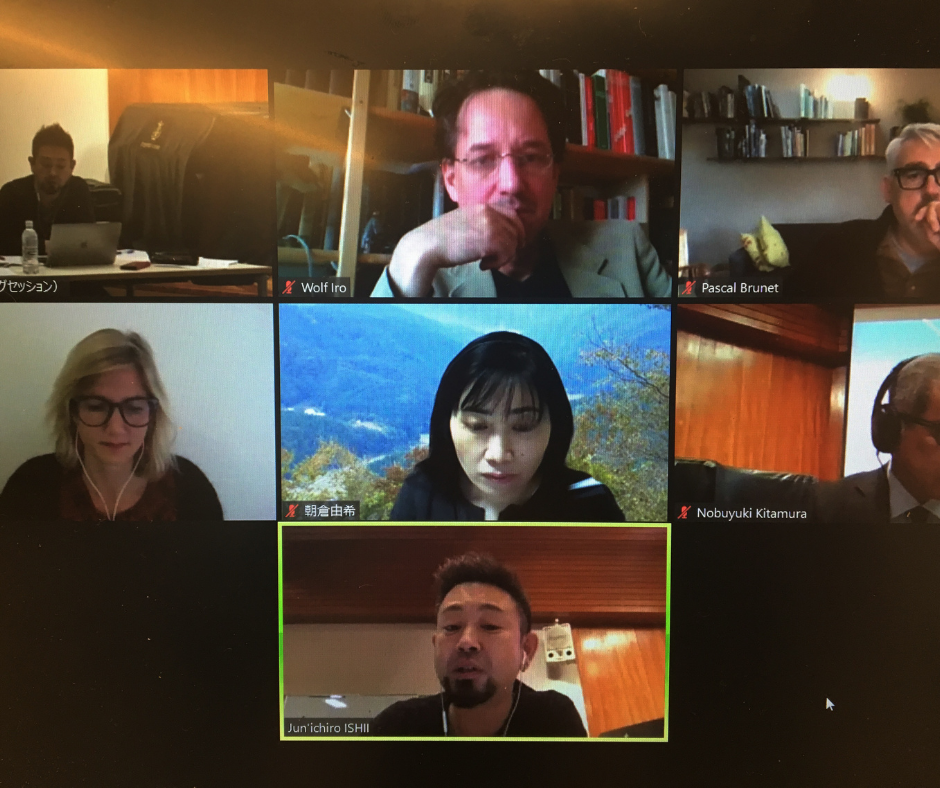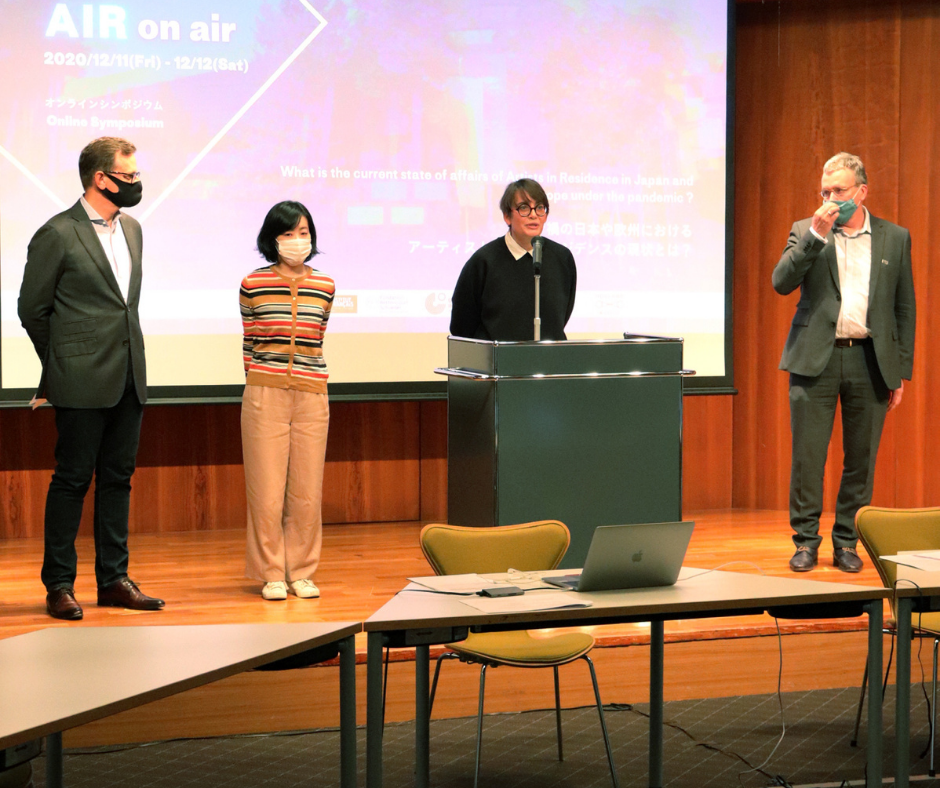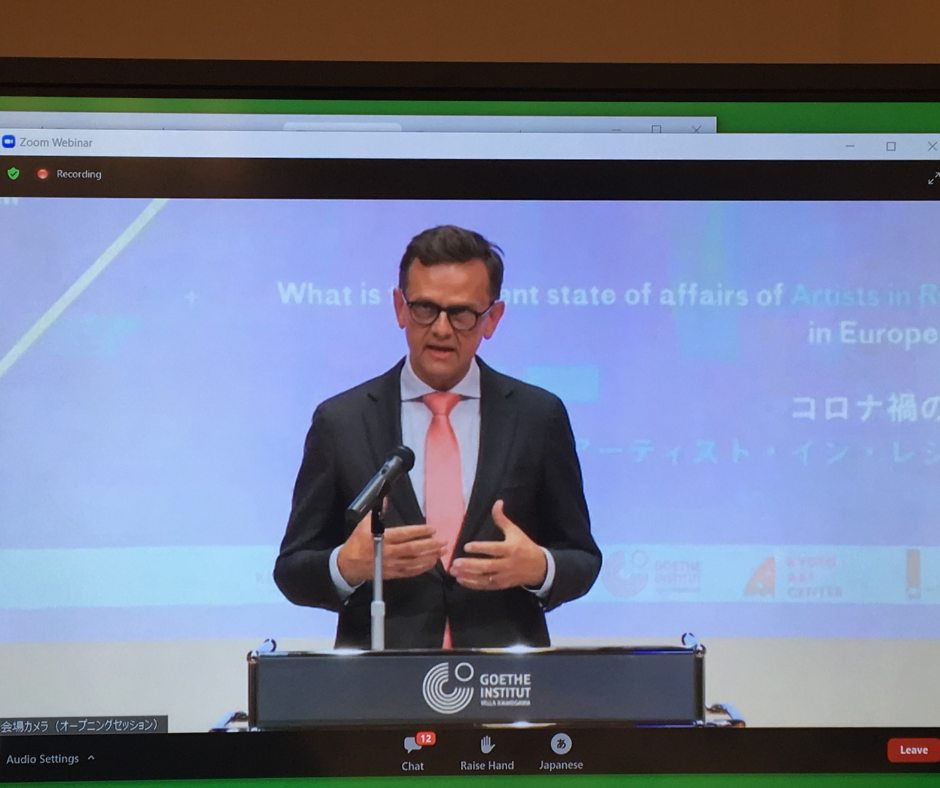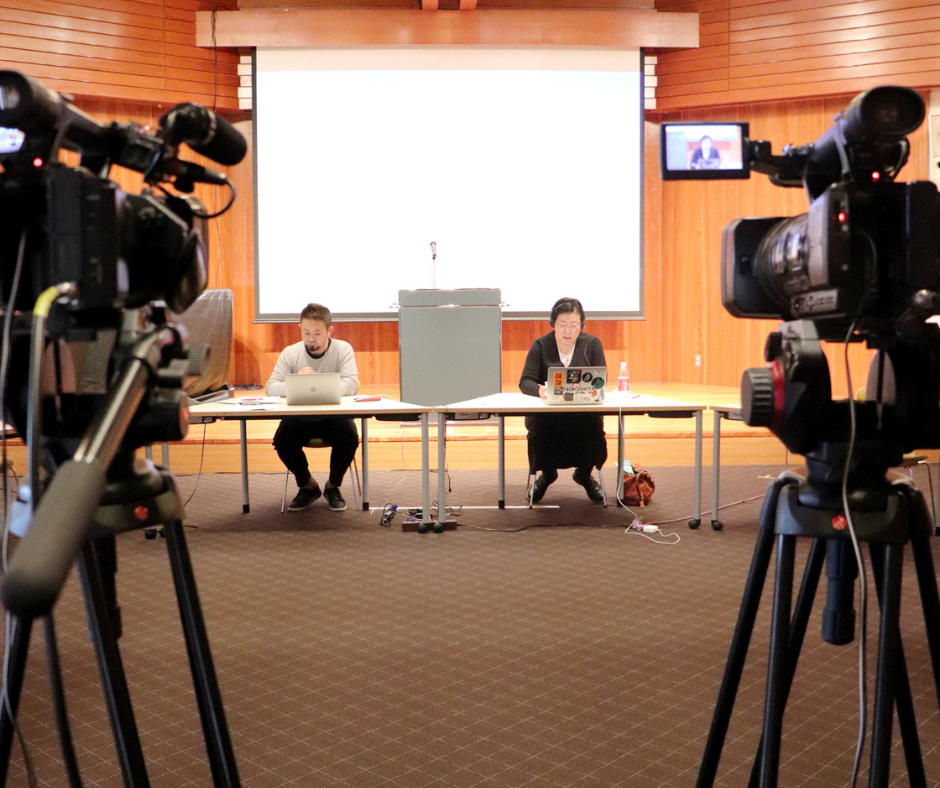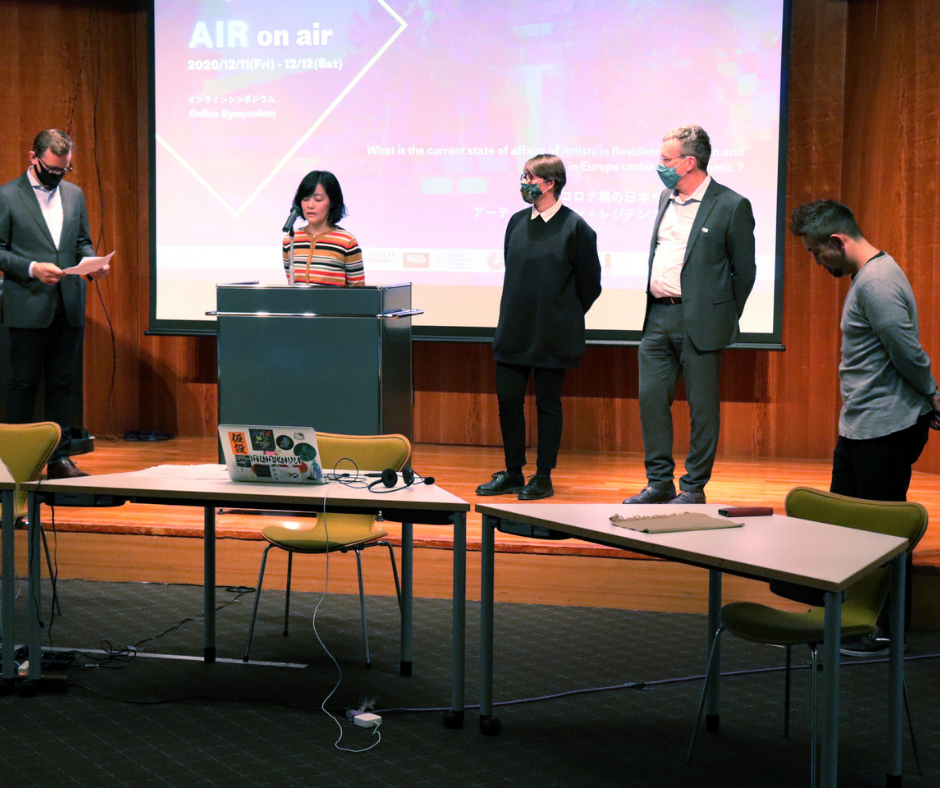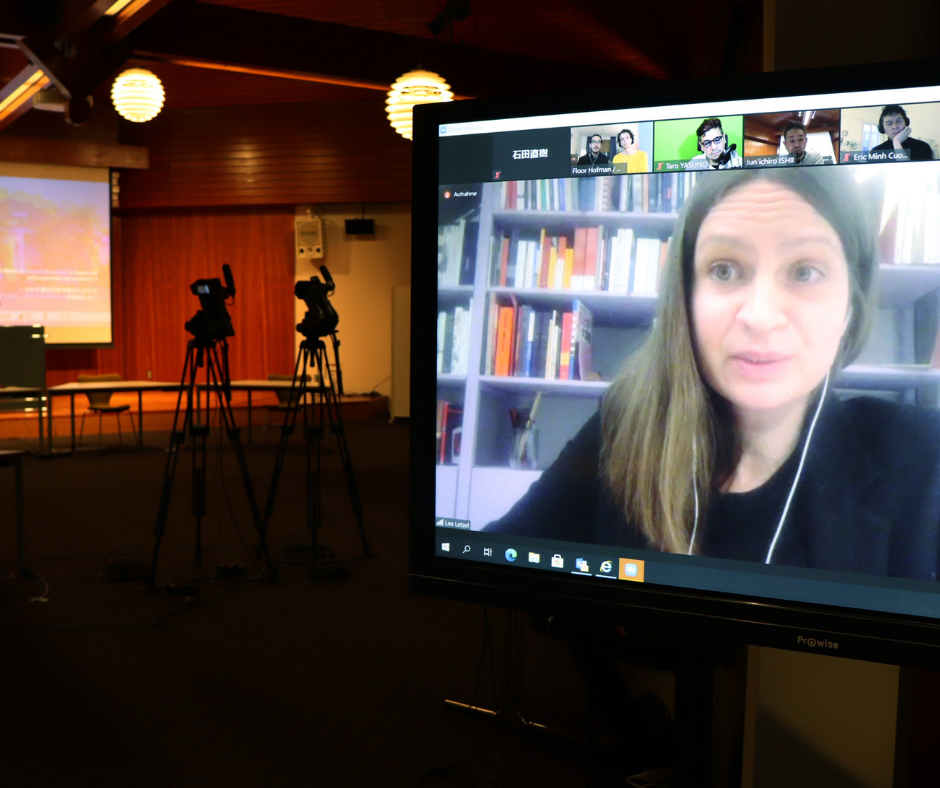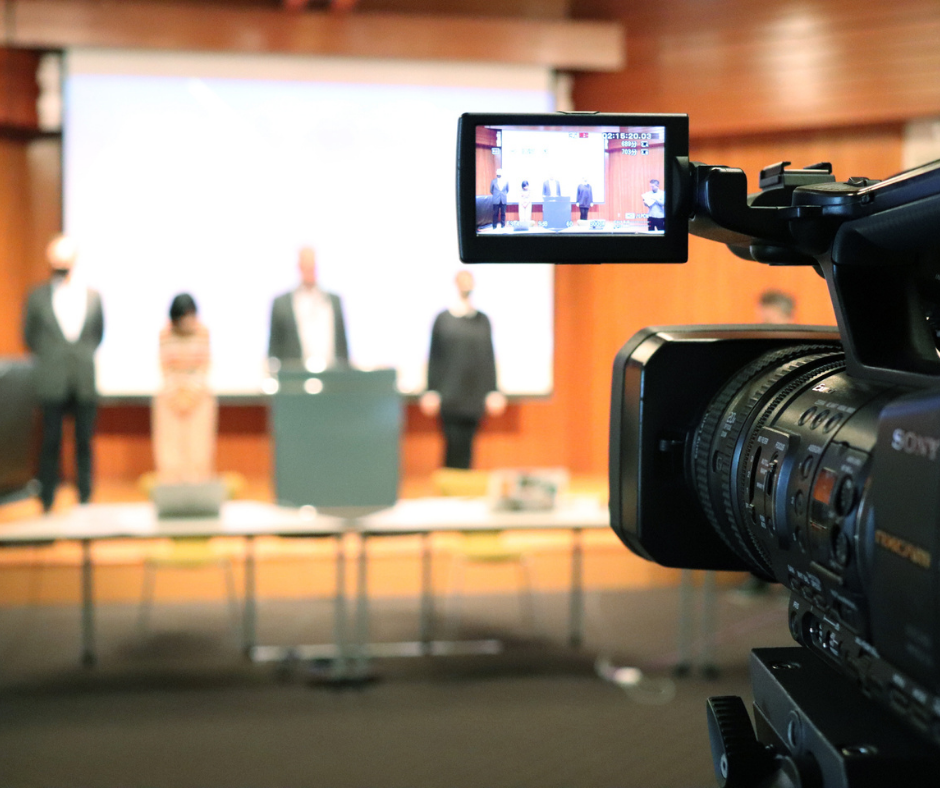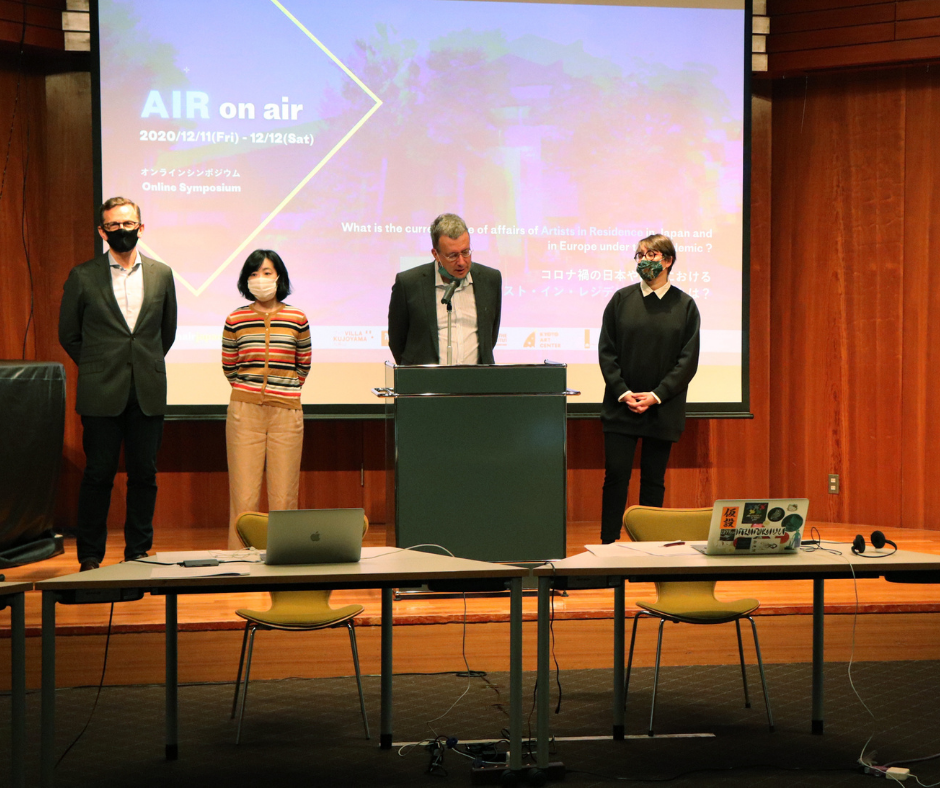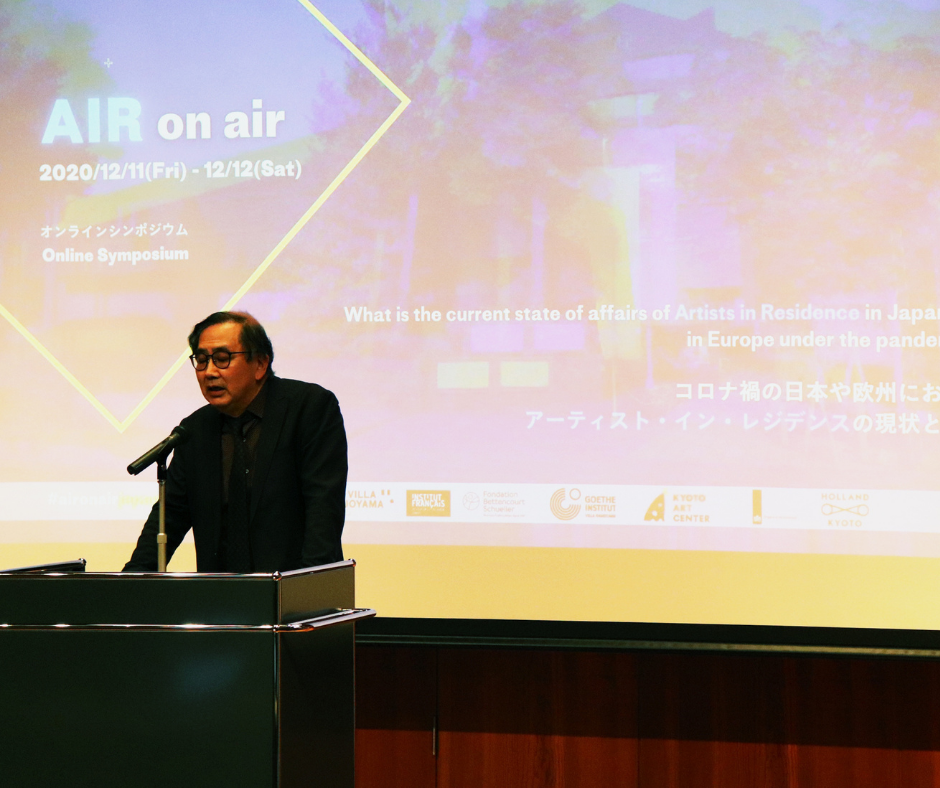10 avr Artist in Residence under the pandemic – report on AIR on air Symposium AIR on air オンラインシンポジウム- パンデミック下におけるアーティスト・イン・レジデンス報告書
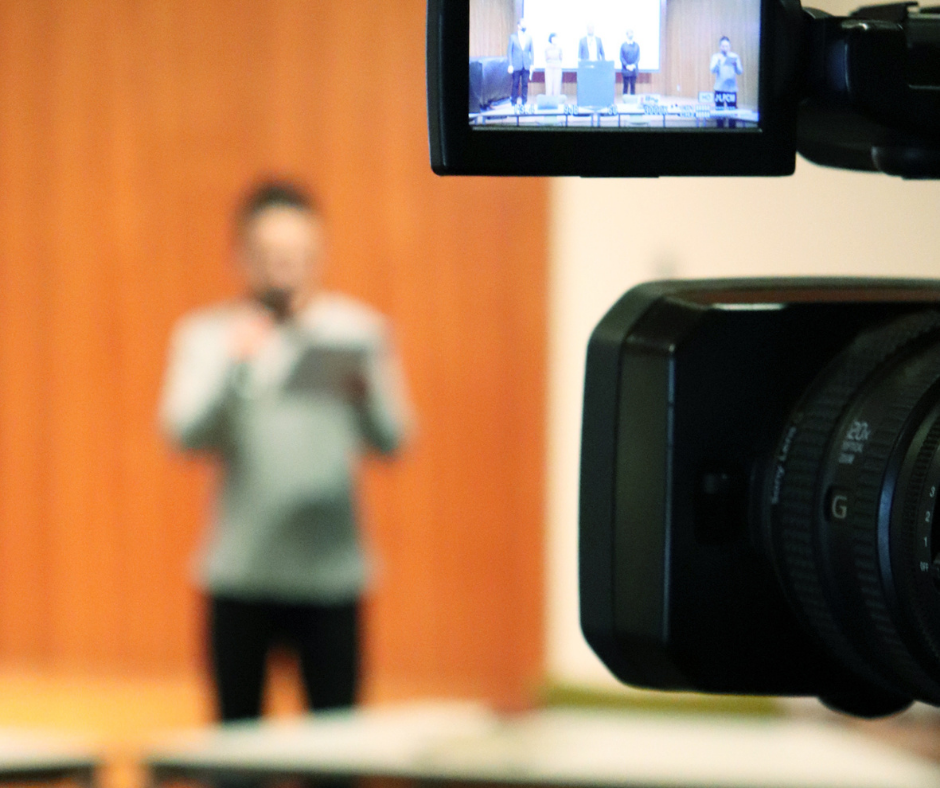
Villa Kujoyama, Villa Kamogawa, Kyoto Art Center, Embassy of the Kingdom of the Netherlands supported by AIR Network Japan and AIR_J organizde the online conference ‘AIR on air’ about the state of affairs in the Artist in Residence (AIR) sectors in France, Germany and the Netherlands after almost one year since the outbreak of COVID-19 on Friday 11 and Saturday 12 December 2020.
Bringing together a broad spectrum of speakers comprising representatives of various cultural institutes, AIR organizers, and artists from France, Germany, the Netherlands, Japan and various other countries, the AIR on air Symposium provided an important opportunity to share experiences and responses to the COVID-19 pandemic in relation to AIR and the cultural sector in general.
Through four themed online sessions that took place over two days in Kyoto, diverse perspectives were shared in order to gauge how views on the future of AIR and international cooperation have changed and consider how AIR might develop in the near or distant future.
⬇ Discover the full report wrote by Jaime Humphreys ⬇
2 DAYS PROGRAM
Download the PDF program
Current Status of AIR
In the opening session on December 11th, representatives of cultural institutes and AIR in respective countries outlined how lockdowns and restrictions on movement implemented in response to COVID-19 have drastically affected the regions in which they operate.
In the EU, Pascal Brunet, director of Relais Culture Europe, described how preliminary estimates indicate 20 to 30 percent destruction of the economy of culture in the region. Speaking about the situation in Japan, Nobuyuki Kitamura, supervising director of Culture and Art Affairs for the City of Kyoto, explained that many events, performances and exhibitions in the field of arts and culture were cancelled or postponed despite comparatively fewer numbers of infections than in most EU countries, and while activities have restarted little by little, the number of performances and visitor numbers have not returned to levels seen before COVID-19. Regarding AIR, organizations in both regions have been seriously affected, leading many planned residencies to be modified, cut short, or postponed.
Mami Odai, director of Sapporo Tenjinyama Art Studio in Japan, summarized the results of a survey conducted by AIR Network Japan, a network of Japan-based AIR for which she serves as vice president. Out of responses from 62 organizations, 70 percent are currently still in operation despite the challenges posed by the pandemic. Odai also explained that a positive consequence has been a greater level of communication among domestic AIR organizers, which in part led to the realization of online information-sharing events for Japan-based AIR.
In response to the pandemic, cultural institutes in both regions have shifted their approach in order to support artists and the creative industries. In addition to providing financial assistance to artists and organizations to help cover costs incurred by cancelled or suspended events and programs, support also took the form of assistance with the creation of online platforms. Wolf Iro, head of the Cultural Department of Goethe-Institut, spoke about the International Fund for Cultural Institutions in Need, a comprehensive scheme set up by the Goethe-Institut to provide infrastructural support that covers rent and staff salaries, as well as equipment and training needed to make the shift to online formats.
It was generally agreed among speakers that flexibility was essential in providing appropriate responses to the changing situation, giving funding recipients more time to undertake planned residencies or exhibitions.
In the discussion that followed the presentations, the issue of decarbonization was raised by several speakers in relation to current practices in AIR and the cultural sector in general, emphasizing the need for all actors to address green mobility and consider global impacts at the regional level from here on. Resulting in a buildup of projects and performances awaiting dissemination, the pandemic has also raised broader questions about conventional methods of production and dissemination,
pointing to a drastic reappraisal of the economy of culture.
AIR Strategies – Possibilities for Virtual Residencies
On the second day, the first session brought together directors of a broad range of AIR based in Japan and the EU, from government funded programs to privately-run “micro” residencies, in order to discuss specific strategies undertaken during the pandemic.
Travel restrictions have inevitably caused major disruptions to international residencies, leading to the cancellation or postponement of many planned residencies. Claus Heimes, director of bangaloREsidency (Goethe-Institut Bangalore), described how the bangaloREsidency had entered a period of “hibernation” until such time as physical residencies are again possible. As part of a wider spectrum of cultural programs organized by the Goethe-Institut Bangalore, the bangaloREsidency does not have a permanent physical space but instead works with local partners to provide such facilities. As a result, the program is not under the same existential pressure as artist residence programs that are tied to physical spaces.
Bénédicte Alliot, the general director of Cité internationale des arts in France, and Izumi Sakamoto, director of AIRY in Japan related how the pandemic had left some artists stranded midway through their residency, leading to urgent fundraising in the case of Cité internationale des arts and strong support from the local community in the case of AIRY. A number of creative strategies were shared to show how AIR had adapted planned residencies to online platforms or created new programs in direct response to the needs of the artists and communities they serve. One such example was the effective utilization of unused facilities by local artists less affected by travel restrictions. In a discussion about the viability of virtual residencies as an alternative to in-person exchange, views were clearly divided.
While it was argued that the physical experiences and encounters provided by AIR are essential, Miriam Wistreich, the creative director of Hotel Maria Kapel (NL) countered that the core role of AIR to give artists time and space in which to work while provoking new thoughts and experiences could also be offered in an online residency. She later added that the idea of having “space” to pursue an artistic practice is closely linked to financial stability, and that a funded online residency could provide a different but equally valid “space” for artists who are unable to undertake international residencies for financial or other reasons.
Artists’ experiences and views on AIR in the pandemic
The potential of virtual residencies was further discussed in the second session, where artists whose residencies had been affected by the pandemic in various ways, directly or indirectly, were invited to share their experiences.
After joining an online residency hosted by Paradise AIR in Japan from their activity base in the Netherlands, Willy Wong & Floor Hofman described how the collaborative project they realized together with local residents had stimulated imaginations in unexpected ways. Through mutually sharing photos and videos each had taken of their urban environments, the physical distance between participants gradually disappeared and led to intimate exchange. While the consensus in this session was that the experiences offered by AIR are irreplaceable, it was also argued that online formats merit greater exploration for fostering new forms of communication and engagement, pointing to the possibility of developing hybrid AIR that combine both formats in the future.
The difficulty of disseminating work amidst the widespread closure of art museums and other cultural institutions due to the pandemic was also touched upon in this session. Several speakers talked of adapting planned exhibitions to the current situation, either by limiting visitor numbers or moving presentations online. In the case of Japanese artist Taro Yasuno, the pandemic had in part prompted him to launch his own YouTube channel as a means of attracting new audiences. Alternatively, Lea Letzel made a radical proposal regarding cultural spaces in her native Germany. After describing how rising infection rates had led cultural spaces to close while shops remained open to allow consumption to continue, she proposed a different strategy to lower rates of infection: Since the cultural institutions have worked so diligently to develop safety measurements for visitors, why not only allow such facilities to open and instead close shops? While admitting the impossibility of such a scheme ever being adopted, Lea’s comment served to draw attention to the difficulties facing spaces that support the dissemination of culture.
AIR Affecting Change – The Future of AIR
In the third and final session, the vital role that AIR serve in supporting artists was highlighted, particularly at a time when many are facing precarious circumstances.
Heidi Vogels, an artist and AIR researcher working for DutchCulture, also spoke about how the pandemic had raised the issue of “care” in society and similarly in the field of AIR, as cultural spaces that host and care for artists. The pandemic has encouraged greater discussion about the role and responsibilities of AIR from a range of perspectives, with the goal of bringing positive change amidst recent social and political unrest.
On the other hand, the discussion also returned to the issue of decarbonization raised in former sessions. While there was general agreement that the physical experience of residencies is irreplaceable, moderator Jun’ichiro Ishii posed the question, “What will become the future standard for running international AIR programs by which their environmental impacts can be justified?” In response, it was suggested that AIR of a longer duration should be given greater priority, while it will also be important for artists to consider whether an AIR requiring long- distance travel is economically and ethically justifiable. International residencies offer great experiences, but participation in AIR closer to home is more likely to lead to long-lasting relationships.
The session also served as an opportunity to share examples of how AIR can directly engage with people and social issues in different areas of society, affecting change in unexpected places. Among them, the Pact(e) program introduced by Sandrina Martins, general director of Le Carreau du Temple in France, was memorable for the unique collaborations it achieved between artists and company employees through the organization of artist residencies in companies. As a result of the program, employees who would otherwise have little contact with contemporary art were given a sense of empowerment in being able to work directly with artists.
Following the session, moderator Jun’ichiro Ishii was joined by observer Teiko Hinuma, director of Rikuzentakata AIR Program in Japan, in a discussion reflecting on the symposium and their own thoughts about the effects of the pandemic.
After describing some of his own residency experiences as an artist, Jun’ichiro went on to describe how, in his view, the shared experience of the pandemic has reminded us of the importance of developing a cosmopolitan viewpoint, where there is a greater empathy towards others who face problems we may ourselves experience in the future.
The rise of online communication due to physical restrictions of movemen thas, he felt, also encouraged us to use our imaginations once again, as people had before the popularization of commercial air travel and the Internet.
Teiko described how discussions during the symposium had echoed her own thoughts during the pandemic, namely the importance, as AIR organizer, of reconsidering the origin of AIR as spaces that offer “safety and hospitality” to artists. This, in her view, is something that AIR organizers tend to forget amidst budgetary concerns, societal commitments, and the need to engage audiences. In addition, she outlined three points that she felt AIR organizers should address in deciding to continue their programs in an online format:
1. To continue to make artists feel welcome and show a commitment to their safety when restarting residencies in the near future;
2. To ensure that the residency challenges the artist in some way, either by bringing them in contact with a different culture or by presenting some form of social problem to address;
3. To provide a platform for sharing experiences. Regarding the last point in particular, Teiko stressed how the symposium had served to demonstrate the importance of networks in making such platforms possible.
In the closing speech, Akira Tatehata, director of Kyoto Art Center, reiterated a point made throughout the discussions: while the pandemic has made physical residencies difficult, it has also led to new forms of communication and deepened dialogue among peers in the field. Serving as a prime example, this symposium has shown the organizers the potential of an online gathering, while also revealing the need to delve deeper into some of the subjects discussed. The organizers are currently planning to organize smaller follow-up meetings focused on specific subjects that emerged during the symposium but which require further discussion, among them being the theme of AIR as actors of change.
Organizers:
Villa Kujoyama, Goethe-Institut Villa Kamogawa, Kyoto Art Center, Embassy of the Kingdom of the Netherlands.
Supported by:
AIR Network Japan, AIR_J
Inquiries:
Villa Kujoyama – Satsuki Konoike
Goethe-Institut Villa Kamogawa – Junko Yamaoka
Kyoto Art Center – Mami Katsuya
Embassy of the Kingdom of the Netherlands – Bas Valckx

